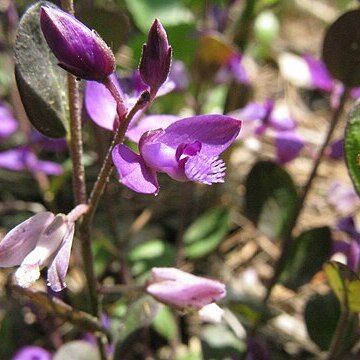Perennial herb or subshrub, diffuse prostrate or branches ascending or erect, up to c. 30 cm high; indumentum of curved hairs. Leaves ± sessile, elliptic to ovate, 5–20 mm long, 3–10 mm wide; apex acute to obtusely angled, mucro 0–0.2 mm long. Inflorescence leaf-opposed or supra-axillary, sometimes a solitary flower usually a short raceme to 30 mm long, exceeding the leaves or shorter than leaves. Pedicel 2–6 mm long. Alae ascending to perpendicular in fruit (position), mauve to blue, ovate to obovate, 4–6 mm long, 1.5–2.5 mm wide, glabrous. Corolla purple and cream; floral appendages much divided; upper petal claw 1 mm wide. Stamens terminate at stigma, nearly connate to apex, monadelphous; staminal flap c. 0.75 mm wide. Style ± straight becoming bent at apex, with 2 stigmas, one apical and globular (sterile) and the other lateral and globular, in dried state style laterally compressed below lateral stigma, dorsoventrally compressed above. Capsule orientation variable, ± aligned to alae or apex of alae diverging to c. 30° from capsule, with wing (the wing c. 0.5 mm wide, ± equal throughout), orbicular to broadly obcordate, 3–8 mm long, 3–8 mm wide; lobe apices rounded and separated. Seed ovoid, c. 2.5–3.0 mm long, c. 2 mm wide, with indumentum of fine white or ferruginous hairs. Aril head hooked, c. 0.6 mm long, white, with short hairs. Aril appendages 3, linear to oblong, c. 1 mm long.
Perennial, prostrate or ascending, branched undershrub 10-20 cm high, mostly developing a woody, rhizomatous, erect root crown or stem base. Stem terete, becoming woody at the base, set with short curved hairs. Leaves ovate to elliptic, the lower ones proportionally broadest, 5-15 by 3-8 mm, sub-sessile, acute, with slightly recurved margin, prominent-reticulate veined, mostly minutely hairy on at least midrib and margin, in transmitted light faintly finely punctate-dotted. Racemes supra-axillary, the free part 1-3 mm long, rather few-flowered. Bracts and bracteoles early caducous. Flowers 5-7 mm long, mauve or purple to deep lavender. Sepals mucronate, the outer shortly hairy, the alae elliptic, 3-5-nerved. Upper petals oblong, rarely (JACOBS 7428) absent or very much reduced, hairy inside in basal half; keel articulate, with 2 much-incised appendages. Filaments (nearly) connate to apex. Ovary broadly obovate, glabrous; style (nearly) straight, subapically at inner side with 2 small, spaced (1 mm) stigmatic lobes, the lower one ± knob-like. Capsule broader and somewhat shorter than the alae, c. 4-5 by 5 mm, emarginate apically, with a rather wide (c. 1 mm), veined membraneous margin which is apically often wider than basally. Seeds ± ovoid, at micropylar side with an unequally 3-lobed aril, black, hairy.
A herb or small shrub. It keeps growing from year to year. It is 10-20 cm high and spreads 10-20 cm wide. It has a woody taproot. The stems can be erect or lie along the ground. The young growth has curly hairs. The leaves are 0.5-2.2 cm long by 0.3-0.8 cm wide. They are oval and dark green. The flowers are 0.6 cm across in groups 1-3 cm long. These are in the axils of leaves. They are mauve or purple. The capsule is about 0.4 cm across and round. It has wings. Now Polygala sibirica

